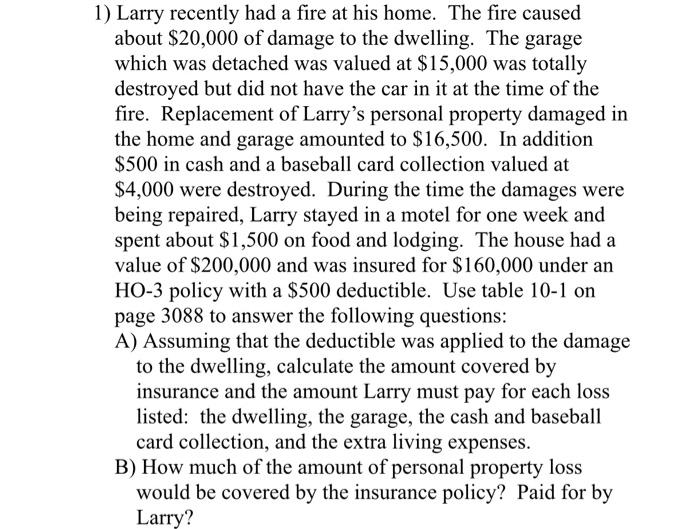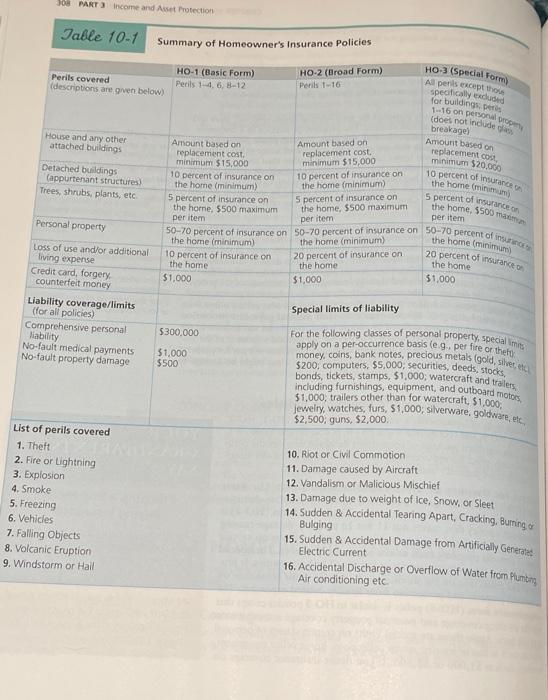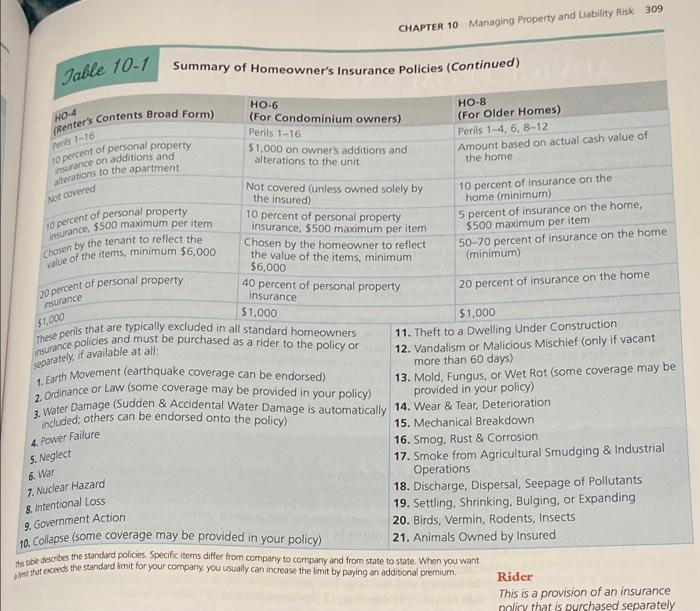1) Larry recently had a fire at his home. The fire caused about $20,000 of damage to the dwelling. The garage which was detached was valued at $15,000 was totally destroyed but did not have the car in it at the time of the fire. Replacement of Larry's personal property damaged in the home and garage amounted to $16,500. In addition $500 in cash and a baseball card collection valued at $4,000 were destroyed. During the time the damages were being repaired, Larry stayed in a motel for one week and spent about $1,500 on food and lodging. The house had a value of $200,000 and was insured for $160,000 under an HO-3 policy with a $500 deductible. Use table 10-1 on page 3088 to answer the following questions: A) Assuming that the deductible was applied to the damage to the dwelling, calculate the amount covered by insurance and the amount Larry must pay for each loss listed: the dwelling, the garage, the cash and baseball card collection, and the extra living expenses. B) How much of the amount of personal property loss would be covered by the insurance policy? Paid for by Larry? 308 PART 3 income and Asset Protection Table 10-1 Summary of Homeowner's Insurance Policies Perils covered (descriptions are given below) HO-1 (Basic Form) Perils 144.6, 8-12 HO-2 (Broad Form) Perils 1-16 1-16 on personal House and any other attached buildings HO-3 (Special Form) Aperiis except those specifically excluded for buildings (does not indude breakage Amount based on replacement cost minimum $20.000 10 percent of insurance the home (mirum 5 percent of insurance the home. $50 mm Detached buildings Cappurtenant structures) Trees, shrubs, plants, etc. Amount based on replacement cost minimum $15,000 10 percent of insurance on the home (minimum) 5 percent of insurance on the home. 5500 maximum per item per item 50-70 percent of insurance on 50-70 percent of insurance on S0-70 percent of the home (minimum) the home (minimum) 10 percent of insurance on 20 percent of insurance on the home the home the home $1,000 $1,000 $1.000 Amount based on replacement cost. minimum $15,000 10 percent of insurance on the home (minimum) 5 percent of insurance on the home, $500 maximum per item Personal property the home (minimum 20 percent of insurance Loss of use and/or additional living expense Credit card, forgery counterfeit money Liability coverage/limits (for all policies) Comprehensive personal liability No-fault medical payments No-fault property damage Special limits of liability $300,000 $1,000 $500 For the following classes of personal property, special apply on a per-occurrence basis (eg. per fire or the money, coins, bank notes, precious metals (gold, sie, including furnishings, equipment, and outboard motors bonds, tickets, stamps, $1,000, watercraft and Trailers $1,000, trailers other than for watercraft, $1,000, jewelry, watches, furs, $1,000, Silverware, goldware, $2,500, guns, $2,000 List of perils covered 1. Theft 2. Fire or Lightning 3. Explosion 4. Smoke 5. Freezing 6. Vehicles 7. Falling Objects 8. Volcanic Eruption 9. Windstorm or Hall 10. Riot or Civil Commotion 11. Damage caused by Aircraft 12. Vandalism or Malicious Mischief 13. Damage due to weight of Ice, Snow, or Sleet 14. Sudden & Accidental Tearing Apart, Cracking, Burningar Bulging 15. Sudden & Accidental Damage from Artificially Generatas Electric Current 16. Accidental Discharge or Overflow of Water from Plumbing Air conditioning etc CHAPTER 10 Managing Property and Liability Risk 309 Table 10-1 Summary of Homeowner's Insurance policies (Continued) HO.4 (Renter's Contents Broad Form) HO-8 (For Older Homes) Perils 1-4, 6, 8-12 Amount based on actual cash value of the home Perde -16 TO percent of personal property insurance on additions and aterations to the apartment Mor covered 10 percent of personal property insurance, 3500 maximum per item Chosen by the tenant to reflect the value of the items, minimum 56,000 20 percent of insurance on the home 20 percent of personal property insurance $1,000 HO-6 (For Condominium owners) Perils 1-16 $1,000 on owner's additions and alterations to the unit Not covered (unless owned solely by 10 percent of insurance on the the insured) home (minimum) 10 percent of personal property 5 percent of insurance on the home, insurance, $500 maximum per item $500 maximum per item Chosen by the homeowner to reflect 50-70 percent of insurance on the home the value of the items, minimum (minimum) $6,000 40 percent of personal property insurance $1,000 $1,000 These perils that are typically excluded in all standard homeowners surance policies and must be purchased as a rider to the policy or 11. Theft to a Dwelling Under Construction 12. Vandalism or Malicious Mischief (only if vacant more than 60 days) 1. Earth Movement (earthquake coverage can be endorsed) 13. Mold, Fungus, or Wet Rot (some coverage may be 2. Ordinance or Law (some coverage may be provided in your policy) provided in your policy) Included; others can be endorsed onto the policy) 14. Wear & Tear, Deterioration 15. Mechanical Breakdown 16. Smog, Rust & Corrosion 17. Smoke from Agricultural Smudging & Industrial Operations 18. Discharge, Dispersal, Seepage of Pollutants 19. Settling, Shrinking, Bulging, or Expanding 20. Birds, Vermin, Rodents, Insects 10. Collapse (some coverage may be provided in your policy) 21. Animals Owned by Insured mas ele describes the standard policies for herens chefer from century to company and from starte dostate, when you want met tut eceeds the standard limit for your company, you usually can increase the limit by paying an additional pretium Rider This is a provision of an insurance nolicy that is purchased separately Separately if available at all: 4. Power Failure 5. Neglect 6. War 7. Nuclear Hazard 8. Intentional Loss 9. Government Action









